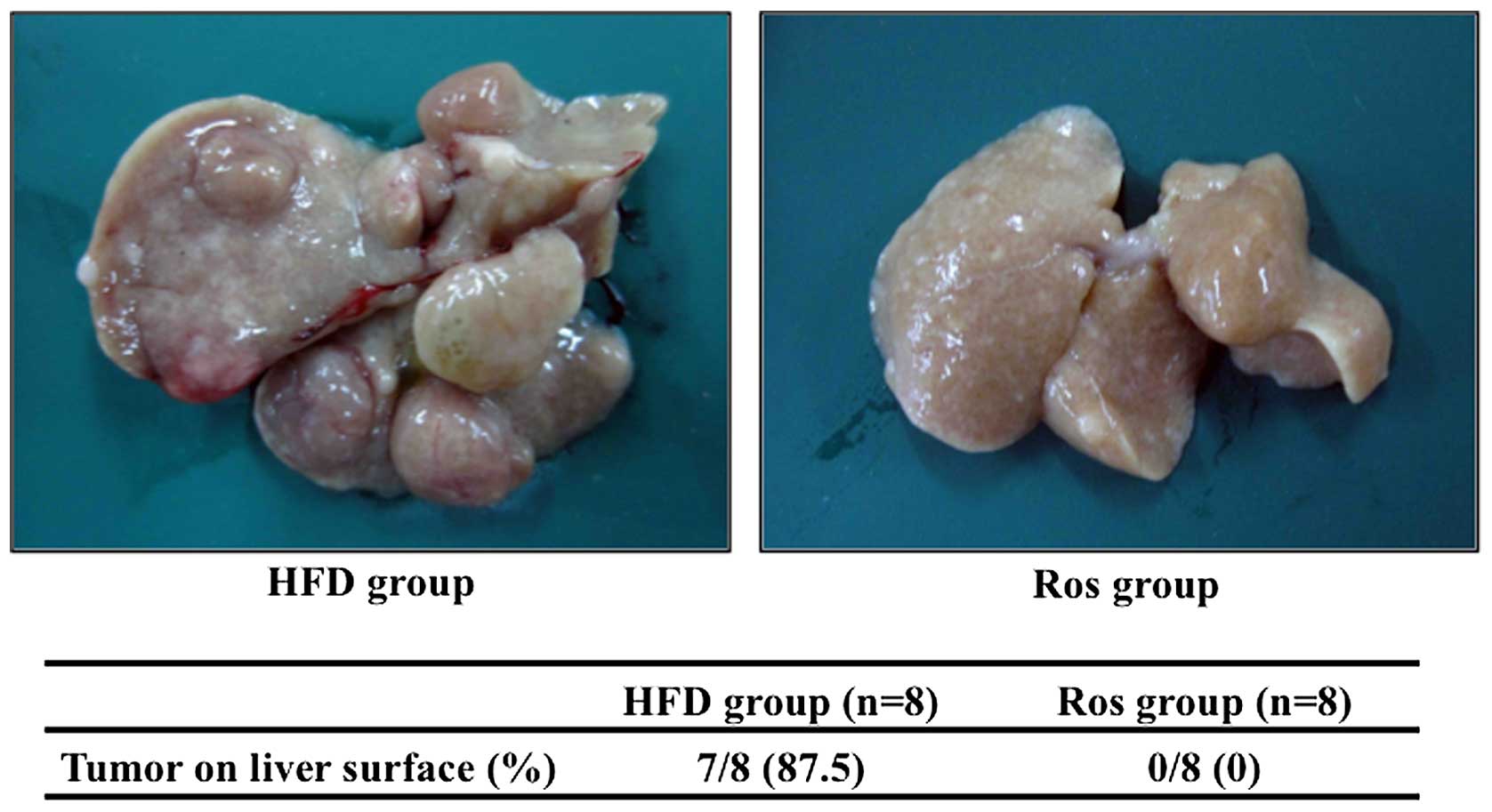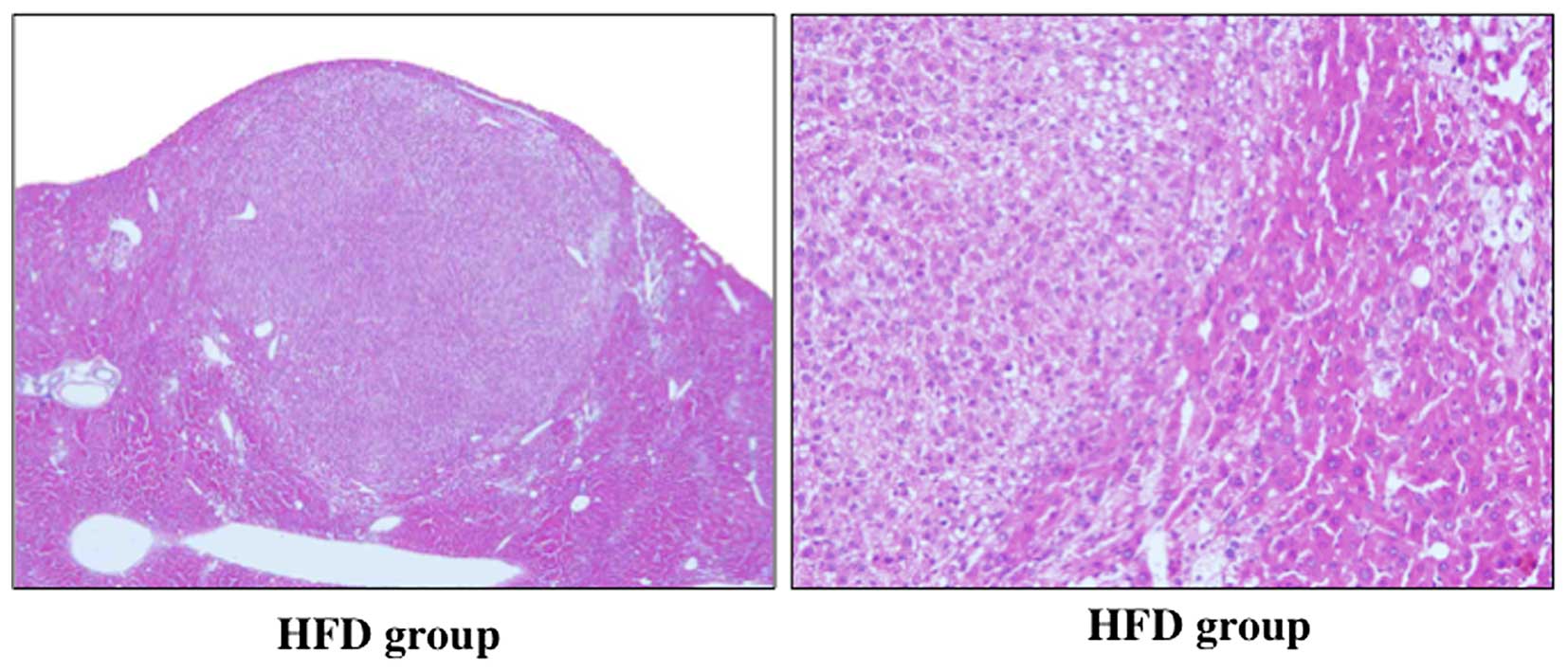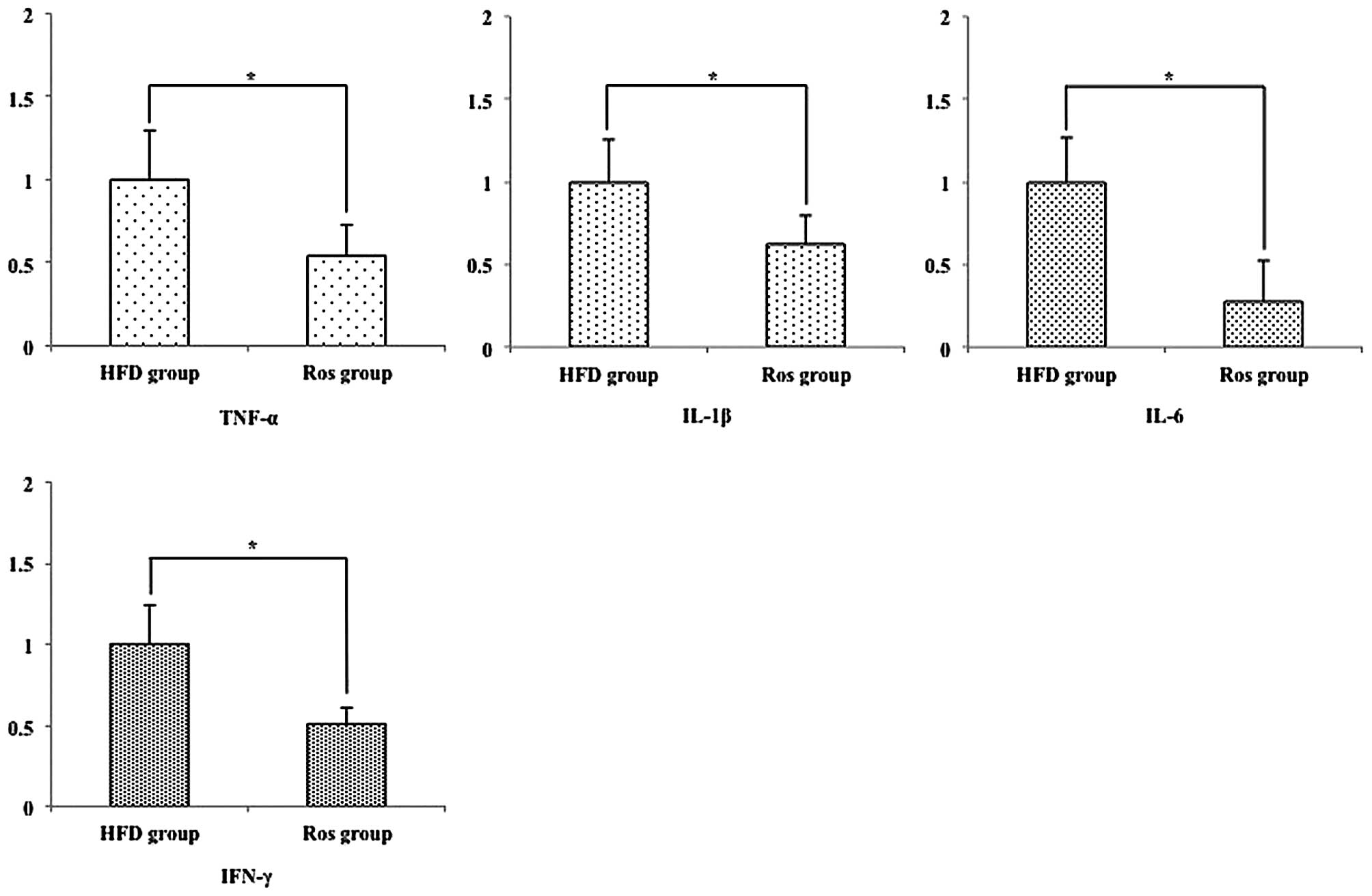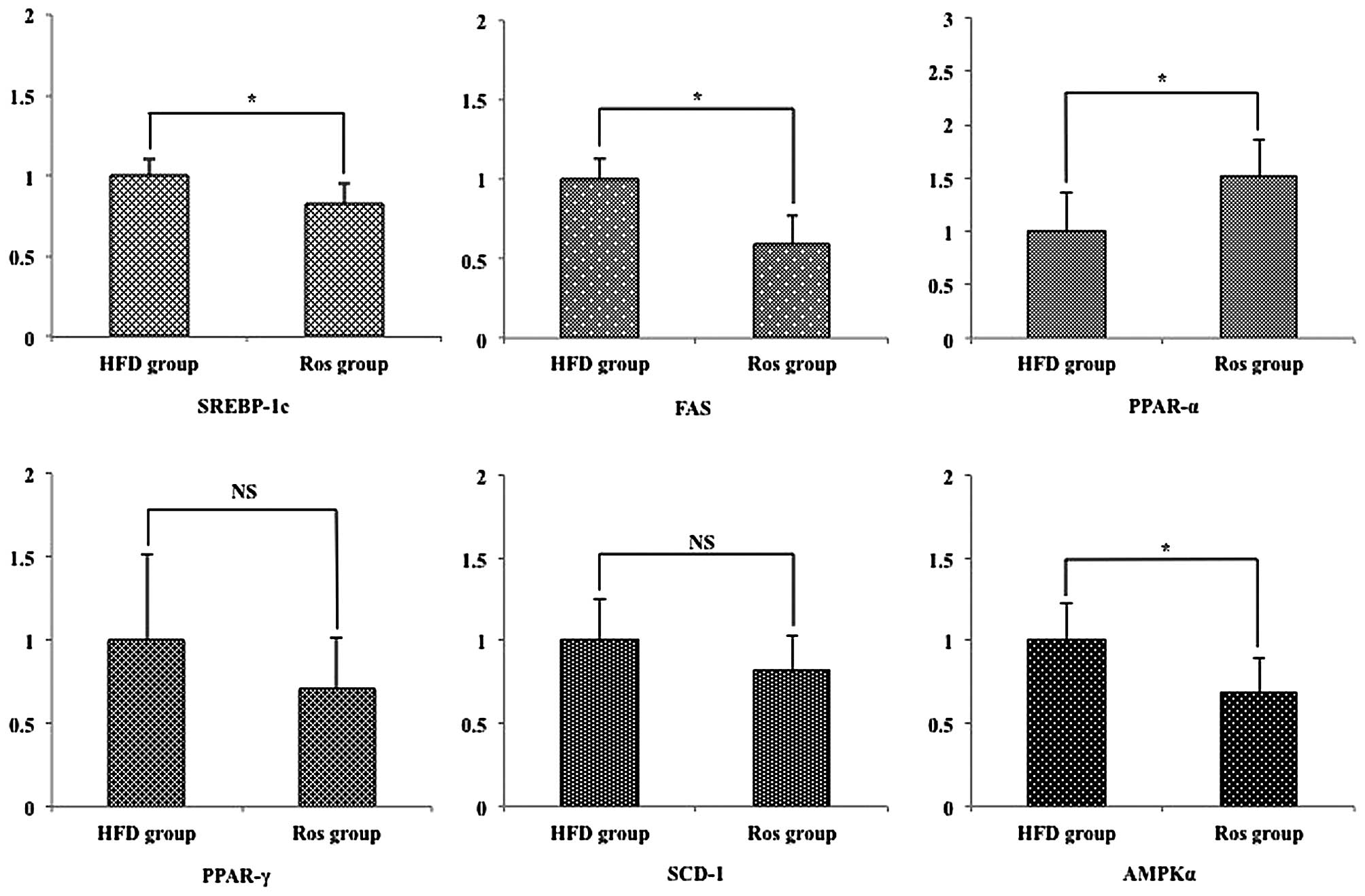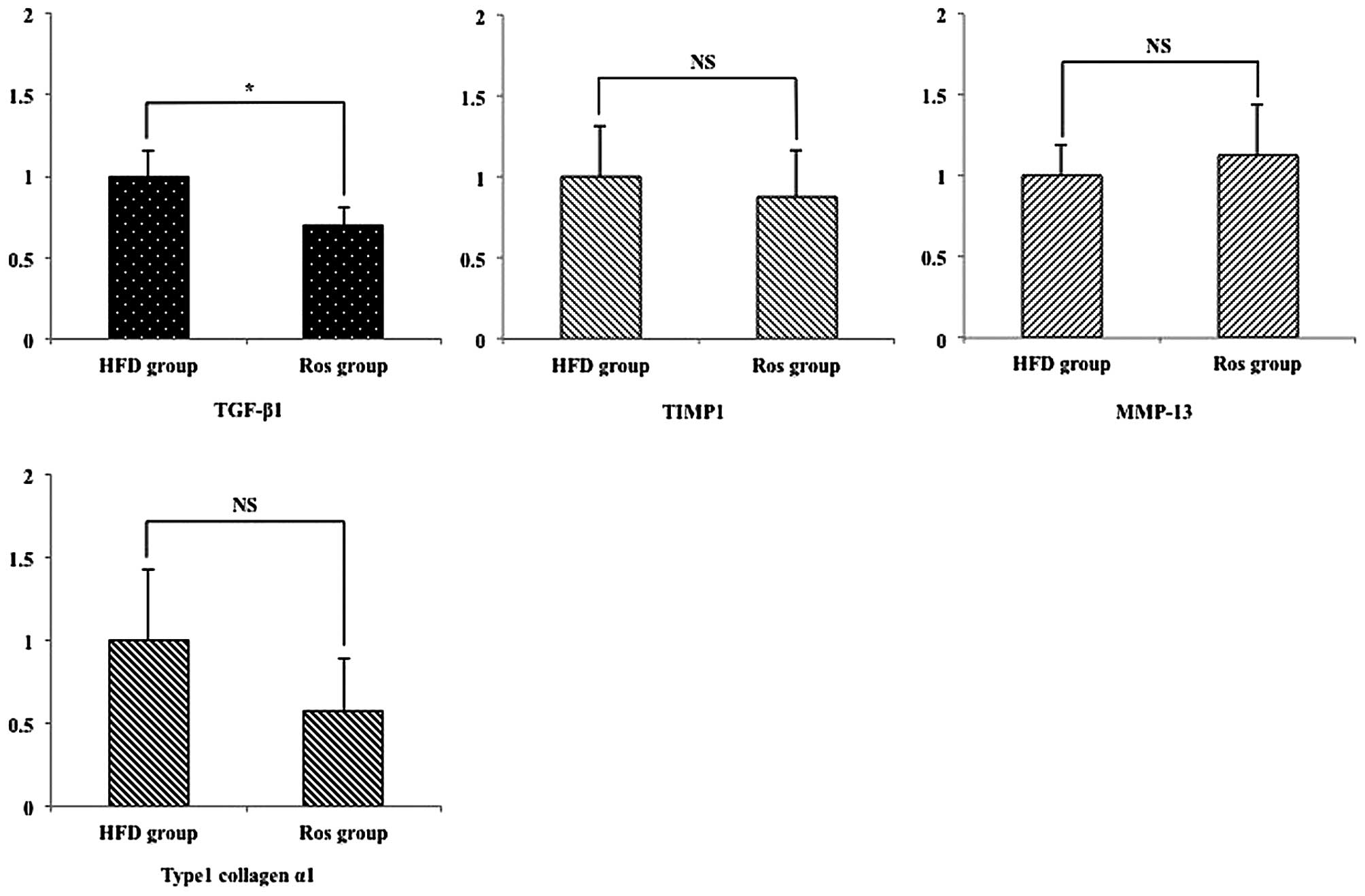Rosuvastatin as a potential preventive drug for the development of hepatocellular carcinoma associated with non-alcoholic fatty liver disease in mice
- Authors:
- Published online on: October 3, 2016 https://doi.org/10.3892/ijmm.2016.2766
- Pages: 1499-1506
Abstract
Introduction
Primary liver cancer is fifth most common type of cancer and has the third highest rates of mortality worldwide. Hepatocellular carcinoma (HCC) represents approximately 85% of all primary liver cancer cases. Although the incidence of some types of cancer is decreasing, the incidence of HCC is increasing worldwide (1,2). A number of risk factors have been identified to increase the risk of HCC. Non-alcoholic fatty liver disease (NAFLD) is one of these risk factors. The histological changes occurring in NAFLD range over a wide spectrum, extending from simple steatosis to non-alcoholic steatohepatitis (NASH), liver cirrhosis and liver failure, and sometimes even HCC (3). NAFLD occurs in patients with components of metabolic syndrome, such as type 2 diabetes mellitus (T2DM), obesity, hypertension and hyperlipidemia (3). Therefore, hyperlipidemia also represents a patient population at risk for HCC that can readily be identified.
Statins are effective drug for patients with hyperlipidemia. The drugs inhibit 3-hydroxy-3-methyl-glutaryl coenzyme A (HMG-CoA) reductase, a key enzyme that catalyzes the rate-limiting step within the cholesterol biosynthetic pathway. Previous studies have shown that statins can exert effects separate their lipid-lowering properties. These non-lipid effects include antioxidant effects (4), anti-inflammatory effects (5) and the upregulation of endothelial nitric oxide synthase (6). Rosuvastatin (Ros), a HMG-CoA reductase inhibitor, has exhibited a more potent affinity for the active site of HMG-CoA reductase than other statins. In addition, the hepatic uptake of Ros in rats has been found to be more selective and efficient than that with other drugs (7). Furthermore, the cytoprotective effects of Ros against ischemic injury have been clearly reported (8–11). Thus, in this study, we aimed to determine the role of Ros as a preventive drug in HCC associated with NAFLD.
Materials and methods
Chemicals and diets
Rosuvastatin Calcium was purchased from AvaChem Scientific (San Antonio, TX, USA). The experimental diets [high-fat-diet (HFD)] were purchased from Oriental Yeast Co., Ltd. (Tokyo, Japan). The energy content of the diet was 5.1 kcal/g, with 56.7% of calories from fat, 20.1% of calories from protein, and 23.2% of calories from carbohydrate, plus vitamins and minerals as recommended. The diets were freshly prepared each day. Ros was administered orally by premixing with the HFD to a concentration of 0.00125% to a concentration of 0.00125%, as these concentrations of the drug have been administered to patients with hyperlipidemia.
Animals
STAM mice, a NASH-cirrhosis-hepatocarcino genic model, were purchased from STELIC Co., Ltd. (Tokyo, Japan). The mouse model was established according to a previously described protocol (12). Briefly, pregnant C57BL/6 mice were purchased from CLEA-Japan (Tokyo, Japan) and 2-day-old male pups were injected with streptozotocin (200 µg/mouse) and fed a HFD (HFD-32; CLEA-Japan) from the age of 4 weeks. This mouse model progresses from NAFLD to NASH at 8 weeks of age and develops HCC at 16 weeks of age (12).
Experimental design
After weaning, 16 mice were divided into 2 experimental groups. The experimental designs were as follows: 5-week-old male STAM mice, which developed T2DM and NAFLD by being fed a HFD, were divided into a group in which a HFD was given to the mice for 15 weeks (n=8) as controls (HFD group); in the other group, the mice were fed a HFD supplemented with 0.00125% Ros for 15 weeks (n=8) (Ros group). The mice were allowed free access to food, with a 12-h light/12-h dark cycle under conditions of controlled temperature (22±1°C) and humidity (50±10%). Food intake was measured daily, while individual body weight was recorded once a week. The 8 mice from each group were fasted overnight prior to euthanasia (by cervical dislocation). All mice were sacrificed after completing their respective dietary regimens, and the livers of the individual animals were weighed. The livers were removed, the samples were placed in formalin and the remainder were snap-frozen and stored at −80°C. All surgical and experimental procedures were performed according to the guidelines for the care and use of animals and approved by the Osaka Medical College Ethics Committee.
Assay for plasma hepatic and metabolic parameters
Blood samples were obtained by cardiac puncture and separated by centrifugation (12,000 rpm, 15 min) as plasma. The levels of blood biochemical parameters, including aspartate aminotransferase (AST), alanine aminotransferase (ALT), free fatty acid (FFA), triglyceride (TG) and total cholesterol (T-CHO) were measured by a local laboratory specified in clinical analyses (Oriental Yeast Co., Ltd.).
Assay for hepatic lipid content
The hepatic tissues were homogenized using a Janke & Kunkel Polytron homogenizer (Ultra-Turrax TP18/1051; IKA Labortechnik, Staufen, Germany) in buffer (pH 7.4) containing 20 mM Tris-HCl, 1 mM EGTA, 2 mM EDTA, and treated with protease inhibitor (2 µg/ml, leupeptin cocktail). Hepatic TG levels were measured by a local laboratory that specifies in clinical analyses (SRL Co. Ltd., Tokyo, Japan).
Histological analysis of hepatic tissue
The liver sections were examined blindly from different lobes of each mouse. Liver tissues were fixed in 10% buffered formaldehyde, and then embedded in paraffin. A 4-mm-thick section cut from a paraffin-embedded block was stained with hematoxylin and eosin (H&E; Applied Medical Research, Osaka, Japan).
Reverse transcription-quantitative PCR (RT-qPCR)
Tissue specimens were preserved in RNAlater reagent (Qiagen, Valencia, CA, USA) until the isolation of the total RNA. Total RNA was isolated from the liver tissues using a QIAshredder and an RNeasy kit (Qiagen). cDNA was prepared using the TaqMan reverse transcriptase kitQiagen (Qiagen). Quantitative (real-time) PCR (qPCR) was performed using the StrataScript First Strand cDNA synthesis kit and FullVelocity SYBR-Green qPCR Master Mix (Stratagene, La Jolla, CA, USA) according to the manufacturer's instructions. The primers used for qPCR were designed using Beagon Designer software version 2.12, according to the parameters outlined in the Bio-Rad iCycler Manual, using reference mRNA sequences accessed through GenBank and as shown in Table I. All probes used in the TaqMan Gene Expression assays were purchased from Applied Biosystems (Foster City, CA, USA). PCR reactions were carried out in the iCycler Thermal Cycler (Bio-Rad Laboratories, Hercules, CA, USA). PCR products were detected using the iCycler IQ Real-Time PCR detection system (Bio-Rad). The relative amount of mRNA was calculated by comparative cycle time determination with the ribosomal protein, RPL32 as the invariant control. Gene expression values were calculated based on the ΔΔCt method. The results were expressed as a fold increase in expression relative to the control group.
Statistical analysis
Data are presented as the means ± standard error of the mean. Statistical analyses were performed using Student's t-test. Values of p<0.05 were considered to indicate statistically significant differences.
Results
Effect of diets on the liver/body weight ratio of the mice in each experimental group
As shown Table II, the ratio of liver weight to body weight did not differ significantly between the 2 groups of mice (7.2±0.56 and 7.5±0.04% in the HFD and Ros group, respectively; p<0.05).
Table IIPlasma and hepatic biochemical parameters and liver weight/body weight ratios of the HFD group and Ros group. |
Plasma and hepatic biochemical parameters
To examine whether Ros, as a preventive drug for the development of HCC associated with NAFLD, affected liver damage and steatosis in our mouse experimental groups, we quantified the plasma levels of AST, ALT, T-CHO, TG and FFA. The plasma AST (HFD, 189.75±441.19 vs. Ros, 138.13±42.84 IU/l; p<0.05) and ALT levels (HFD, 59.88±20.32 vs. Ros, 39.75±6.92 IU/l; p<0.05) differed significantly between the Ros group and HFD group (Table II). Mice fed the diet containing Ros had lower plasma levels of T-CHO (HFD, 161.88±52.14 vs. Ros, 109.13±14.64 mg/dl; p<0.05), FFA (HFD, 514.5±144.15 vs. Ros, 350.75±119.7 µEq/l; p<0.05) and TG (HFD, 150.13±68.16 vs. Ros, 39.0±8.29 mg/dl; p<0.05) (Table II). Mice fed the diet containing Ros also had a lower hepatic TG content (HFD, 38.11±2.44 vs. Ros, 29.99±1.22 mg/dl; p<0.05) (Table II).
Macroscopic examinations
Numerous tumors on the liver surface were observed in 4 out of 5 mice in the HFD group (Fig. 1). On the other hand, no tumors on the liver surface were observed in the mice in the Ros group (Fig. 1).
Histological analysis
Mild hepatic steatosis was observed in the 2 groups (Fig. 2). Hepatic steatosis was however, decreased in the Ros group compared to the HFD group. Although large fatty droplets were observed in the HFD group, no large fatty droplets were observed in the Ros group. Histological findings in the liver of two groups did not show clear inflammatory cell infiltration. The cells in the tumor in HFD group had high nuclear/cytoplasmic ratio, and this finding did not contradict the findings of HCC. These cells were well differentiated. Therefore, histological findings revealed that the tumors were HCC (Fig. 3). On the other hand, histological examinations did not reveal any HCCs in the Ros group (Fig. 2).
Hepatic pro-inflammatory mRNA expression
A previous study demonstrated that several pro-inflammatory cytokines are associated with the development of NASH (13). Therefore, we examined the expression levels of hepatic pro-inflammatory cytokines. The relative hepatic mRNA expression levels of tumor necrosis factor (TNF)-α, interleukin (IL)-1β, IL-6 and interferon (IFN)-γ were significantly decreased in the Ros group compared with the HFD group (all p<0.05) (Fig. 4).
Hepatic lipogenic-related mRNA expression
The differences in the levels of plasma TG and FFA between the 2 groups and the effect of Ros on the development of NAFLD suggest the expression of cytokines involved in the development of NAFLD. Sterol regulatory element binding protein-1c (SREBP-1c) is well known to be involved in these states (14). The relative hepatic mRNA expression levels of SREBP-1c were significantly decreased in the Ros group compared with the HFD group (p<0.05; Fig. 5). Furthermore, it has been reported that SREBP-1 is regulated by a pathway of AMP-activated protein kinase (AMPK) (15). Since fatty acid synthase (FAS) and stearoyl-CoA desaturase-1 (SCD-1) may be critical to the role of triglyceride accumulation in hepatocytes (16), we examined the expression levels of these 3 genes. The relative hepatic mRNA expression levels of FAS were significantly decreased in the Ros group compared with the HFD group. However, there was no significant difference in the hepatic mRNA expression levels of SCD-1 between the 2 groups (Fig. 5). Peroxisome proliferator-activated receptors (PPARs) are nuclear transcription factors that include 3 subtypes: α, β and γ. PPAR-α is a member of the PPAR subfamily of nuclear receptors that transcriptionally promotes peroxisomal, microsomal and mitochondrial oxidation (17). PPAR-γ, another member of the PPAR subfamily of nuclear receptors, transcriptionally activates adipocyte differentiation (18). Thus, we examined the hepatic mRNA expression levels of these genes. The relative hepatic mRNA expression levels of PPAR-α were significantly increased in the Ros group compared with the HFD group (Fig. 5). On the other hand, there was no significant difference in the relative hepatic mRNA expression levels of PPAR-γ between the 2 groups (Fig. 5).
Hepatic pro-fibrogenic mRNA expression
Transforming growth factor (TGF)-β1 is produced by Kupffer cells and activates hepatic stellate cells (HSCs) that play a role in fibrogenesis in the liver (19). Thus, we examined the expression levels of TGF-β1 and fibrogenesis-related genes produced from HSCs, such tissue inhibitors of matrix metalloproteinase (TIMP)-1, matrix metalloproteinase (MMP)-13 and type 1 collagen α1 (19). The relative hepatic mRNA expression levels of TGF-β1 were significantly decreased in the Ros group compared with the HFD group (Fig. 6). However, there was no significant difference in the relative mRNA expression levels of the other genes between the 2 groups (Fig. 6).
Hepatic antioxidant-related mRNA expression
To determine whether Ros detoxifies reactive oxygen species in the Ros group, we then performed RT-qPCR to quantify the expression levels of antoxidant genes, such as GCL catalytic subunit (Gclc) and glutathione S-transferase (GST) (20). The relative hepatic expression of these genes did not differ significantly between the 2 groups (Fig. 7).
Hepatic developing HCC-related mRNA expression
Sorafenib is a useful drug for the treatment of HCC as it inhibits the epidermal growth factor (EGF), vascular endothelial growth factor (VEGF) and platelet-derived growth factor (PDGF) (21,22). Thus, we examined whether Ros inhibits the development of these genes. The relative hepatic mRNA expression levels of EGFR, VEGER and PDGFR were significantly decreased in the Ros group compared with the HFD group (p<0.05; Fig. 8).
Discussion
HCC typically has a poor prognosis, and the majority of patients are diagnosed with progressive liver cancer with a 5-year survival rate of approximately 2%. Therefore, the prevention of HCC is important for reducing its mortality and morbidity. It is considered necessary to identify patients at risk of the occurrence of HCC and to develop a safe chemopreventive agent. Hyperlipidemia is one of the risk factors responsible for the occurrence of NASH, which ultimately causes HCC. An increase in the extent of hyperlipidemia translates to an increase in the risk of the occurrence of HCC. Ros is a hypolipidemic agent. In addition to its anti-hyperlipidemic effect, it has been shown to exert anti-inflammatory and anti-arteriosclerotic effectsin cardiovascular diseases both in vivo and in vitro (4–6). Although Ros is commonly used in hyperlipidemic patients, no study has been reported to date on the effect of the drug on the occurrence of HCC in the presence of an underlying NASH, at least to the best of our knowledge. The present study showed the potential protective effect of Ros against HCC or tumor formation. Our data also showed that this protective effect is not only partially mediated by its anti-inflammatory effect and the downregulation of genes involved in new lipogenesis, but may also be mediated by the downregulation of vascular proliferative factors.
It has beent demonstrated that Ros exerted anti-inflammatory effects not only in cardiovascular diseases, but also on factors involved in the occurrence and progression of NASH (4–6). These findings are consistent with the biochemistry measurements of AST and ALT in our study. In fibrogenesis, however, Ros exerted its effect on TGF-β1, but not on stellate cell-derived factors.
Our results also suggested that Ros exerted its effect on the expression of lipid-related genes. Biochemical analyses revealed that the serum and liver TG levels decreased in the Ros group. To elucidate the mechanism involved, we measured the hepatic expression of some lipogenic and lipid oxidation-related genes in both groups. The results of RT-qPCR assay confirmed that the administration of Ros significantly affected the expression of a number of lipid-related genes. In particular, SREBP-1c (23), a key transcription activator in hepatic lipid synthesis, was significantly decreased in the Ros group, compared with the HFD group. The multi-subunit enzyme, AMPK, is recognized as a major regulator in the hepatic lipid synthesis pathway and fatty acid oxidation (24,25). We found that the expression of the AMPKα1 subunit was higher in the Ros group than in the HFD group. The molecule PPAR-α is a member of the PPAR subfamily of nuclear receptors that transcriptionally promotes peroxisomal, microsomal and mitochondrial oxidation (17). PPAR-α expression in the liver was significantly higher in the Ros group than in the HFD group. By contrast, no significant difference was observed between the two groups as regards the expression of PPAR-γ (18), another member of the PPAR subfamily, which transcriptionally initiates adipocyte differentiation.
It has previously been shown that the administration of eicosapentaenoic acid (EPA), a hypolipidemic agent, to Pten knockout mice induces the expression of antioxidant genes and inhibits the formation of reactive oxygen species. Thus, we considered whether Ros exerts an antioxidant effect such as EPA. In our study, no significant expression of antioxidant genes, such as Gclc and GST, was induced in the livers of mice treated with Ros (20). These findings suggest that Ros has no antioxidant effect on STAM mouse livers.
Importantly, Ros suppressed the occurrence of hepatic adenoma and HCC in the STAM mice used in this study. While this effect has been reported for EPA (26), it has not even investigated for Ros. EPA has been reported to have an antitumor effect originating from cell death induction and cell growth inhibition. In addition to focusing our attention to the already demonstrated effect of Ros on cardiovascular diseases, we investigated the expression of vascular proliferative factors, based on the fact that sorafenib, the only oral treatment for progressive HCC, has a suppressive effect on tumor vessel proliferation. Our results indicated that the expression of vascular proliferative factors, including EGF, VEGF and PDGF, was inhibited by almost 50% in the Ros group, compared with the HFD group. This finding suggests that the hypolipidemic agent, Ros, may have an antitumor effect, in addition to its antihyperlipidemic effect, against HCC associated with NASH.
Ros is a drug used in the treatment of many hyperlipidemic patients. In the present study, we demonstrated that the administration of Ros is a potential treatment for NASH and its final stage, HCC. We suggest that the effects of Ros be evaluated in future prospective and retrospective randomized placebo-controlled clinical studies.
Abbreviations:
|
HCC |
hepatocellular carcinoma |
|
NAFLD |
nonalcoholic fatty liver disease |
|
HMG-CoA |
3-hydroxy-3-methylglutaryl coenzyme A |
|
TNF |
tumor necrosis factor |
|
IL |
interleukin |
|
TGF |
transforming growth factor |
|
VEGFR |
vascular endothelial growth factor receptor |
|
EGFR |
epidermal growth factor receptor |
|
PDGF |
platelet-derived growth factor |
|
NASH |
non-alcoholic steatohepatitis |
|
Ros |
Rosuvastatin |
|
HFD |
high-fat-diet |
|
AST |
spartate aminotransferase |
|
ALT |
alanine aminotransferase |
|
FFA |
free fatty acid |
|
TG |
triglyceride |
|
T-CHO |
total cholesterol |
|
TG |
tissue triglyceride |
|
H&E |
hematoxylin and eosin |
|
RT-qPCR |
reverse transcription-quantitative PCR |
|
IFN |
interferon |
|
SREBP-1c |
sterol regulatory element binding protein-1c |
|
AMPK |
AMP-activated protein kinase |
|
FAS |
fatty acid synthase |
|
SCD-1 |
stearoyl-CoA desaturase-1 |
|
PPAR |
peroxisome proliferator-activated receptor |
|
HSCs |
hepatic stellate cells |
|
TIMP |
tissue inhibitors of matrix metalloproteinases |
|
MMP |
matrix metalloproteinases |
|
Gclc |
GCL catalytic subunit |
|
GST |
glutathione S-transferase |
|
EPA |
eicosapentaenoic acid |
Acknowledgments
The authors would like to thank Yukio Nakahira and Eiko Koubayashi, at the Osaka Medical College, for providing them with technical support.
References
|
El-Serag HB and Rudolph KL: Hepatocellular carcinoma: Epidemiology and molecular carcinogenesis. Gastroenterology. 132:2557–2576. 2007. View Article : Google Scholar : PubMed/NCBI | |
|
Parkin DM, Bray F, Ferlay J and Pisani P: Global cancer statistics, 2002. CA Cancer J Clin. 55:74–108. 2005. View Article : Google Scholar : PubMed/NCBI | |
|
Ludwig J, Viggiano TR, McGill DB and Oh BJ: Nonalcoholic steatohepatitis: Mayo Clinic experiences with a hitherto unnamed disease. Mayo Clin Proc. 55:434–438. 1980.PubMed/NCBI | |
|
Aviram M, Rosenblat M, Bisgaier CL and Newton RS: Atrovastatin and gemfibrozil metabolities, but not the parent drugs are potent antioxidants against lipoprotein oxidation. Antherosclerosis. 138:272–280. 1998. | |
|
Ridker PM, Cannon CP, Morrow D, Rifai N, Rose LM, McCabe CH, Pfeffer MA and Braunwald E; Pravastatin or Atorvastatin Evaluation and Infection Therapy-Thrombolysis in Myocardial Infarction 22 (PROVE IT-TIMI 22) Investigators: C-reactive protein levels and outcomes after statin therapy. N Engl J Med. 352:20–28. 2005. View Article : Google Scholar : PubMed/NCBI | |
|
Laufs U, La Fata V, Plutzky J and Liao JK: Upregulation of endothelial nitric oxide synthase by HMG CoA reductase inhibitors. Circulation. 97:1129–1135. 1998. View Article : Google Scholar : PubMed/NCBI | |
|
Nezasa K, Higaki K, Matsumura T, Inazawa K, Hasegawa H, Nakano M and Koike M: Liver-specific distribution of rosuvastatin in rats: Comparison with pravastatin and simvastatin. Drug Metab Dispos. 30:1158–1163. 2002. View Article : Google Scholar : PubMed/NCBI | |
|
Ikeda Y, Young LH and Lefer AM: Rosuvastatin, a new HMG-CoA reductase inhibitor, protects ischemic reperfused myocardium in normocholesterolemic rats. J Cardiovasc Pharmacol. 41:649–656. 2003. View Article : Google Scholar : PubMed/NCBI | |
|
Bulhak A, Sjoquist PO and Pernow J: Rosuvastatin protects the myocardium against ischaemia-reperfusion injury via inhibition of GGPP synthesis. Cardiovasc J S Afr. 15:S112004. | |
|
Weinberg EO, Scherrer-Crosbie M, Picard MH, Nasseri BA, MacGillivray C, Gannon J, Lian Q, Bloch KD and Lee RT: Rosuvastatin reduces experimental left ventricular infarct size after ischemia-reperfusion injury but not total coronary occlusion. Am J Physiol Heart Circ Physiol. 288:H1802–H1809. 2005. View Article : Google Scholar | |
|
Bulhak AA, Gourine AV, Gonon AT, Sjöquist PO, Valen G and Pernow J: Oral pre-treatment with rosuvastatin protects porcine myocardium from ischaemia/reperfusion injury via a mechanism related to nitric oxide but not to serum cholesterol level. Acta Physiol Scand. 183:151–159. 2005. View Article : Google Scholar : PubMed/NCBI | |
|
Takakura K, Koido S, Fujii M, Hashiguchi T, Shibazaki Y, Yoneyama H, Katagi H, Kajihara M, Misawa T, Homma S, et al: Characterization of non-alcoholic steatohepatitis-derived hepatocellular carcinoma as a human stratification model in mice. Anticancer Res. 34:4849–4855. 2014.PubMed/NCBI | |
|
Gao B: Innate immunity and steatohepatitis: A critical role of another toll (TLR-9). Gastroenterology. 139:27–30. 2010. View Article : Google Scholar : PubMed/NCBI | |
|
Horton JD, Shah NA, Warrington JA, Anderson NN, Park SW, Brown MS and Goldstein JL: Combined analysis of oligonucleotide microarray data from transgenic and knockout mice identifies direct SREBP target genes. Proc Natl Acad Sci USA. 100:12027–12032. 2003. View Article : Google Scholar : PubMed/NCBI | |
|
Foretz M, Ancellin N, Andreelli F, Saintillan Y, Grondin P, Kahn A, Thorens B, Vaulont S and Viollet B: Short-term overexpression of a constitutively active form of AMP-activated protein kinase in the liver leads to mild hypoglycemia and fatty liver. Diabetes. 54:1331–1339. 2005. View Article : Google Scholar : PubMed/NCBI | |
|
Cohen P and Friedman JM: Leptin and the control of metabolism: Role for stearoyl-CoA desaturase-1 (SCD-1). J Nutr. 134:2455S–2463S. 2004.PubMed/NCBI | |
|
Yu S, Rao S and Reddy JK: Peroxisome proliferator-activated receptors, fatty acid oxidation, steatohepatitis and hepatocarcinogenesis. Curr Mol Med. 3:561–572. 2003. View Article : Google Scholar : PubMed/NCBI | |
|
Tontonoz P, Hu E, Graves RA, Budavari AI and Spiegelman BM: mPPAR gamma 2: Tissue-specific regulator of an adipocyte enhancer. Genes Dev. 8:1224–1234. 1994. View Article : Google Scholar : PubMed/NCBI | |
|
Friedman SL: The cellular basis of hepatic fibrosis. Mechanism and treatment strategies. N Engl J Med. 328:1828–1835. 1993. View Article : Google Scholar : PubMed/NCBI | |
|
Gorrini C, Harris IS and Mak TW: Modulation of oxidative stress as an anticancer strategy. Nat Rev Drug Discov. 12:931–947. 2013. View Article : Google Scholar : PubMed/NCBI | |
|
Chaparro M, González Moreno L, Trapero-Marugán M, Medina J and Moreno-Otero R: Review article: Pharmacological therapy for hepatocellular carcinoma with sorafenib and other oral agents. Aliment Pharmacol Ther. 28:1269–1277. 2008. View Article : Google Scholar : PubMed/NCBI | |
|
Siegelin MD, Raskett CM, Gilbert CA, Ross AH and Altieri DC: Sorafenib exerts anti-glioma activity in vitro and in vivo. Neurosci Lett. 478:165–170. 2010. View Article : Google Scholar : PubMed/NCBI | |
|
Tontonoz P, Kim JB, Graves RA and Spiegelman BM: ADD1: A novel helix-loop-helix transcription factor associated with adipocyte determination and differentiation. Mol Cell Biol. 13:4753–4759. 1993. View Article : Google Scholar : PubMed/NCBI | |
|
Hardie DG and Carling D: The AMP-activated protein kinase–fuel gauge of the mammalian cell? Eur J Biochem. 246:259–273. 1997. View Article : Google Scholar : PubMed/NCBI | |
|
Winder WW and Hardie DG: AMP-activated protein kinase, a metabolic master switch: Possible roles in type 2 diabetes. Am J Physiol. 277:E1–E10. 1999.PubMed/NCBI | |
|
Ishii H, Horie Y, Ohshima S, Anezaki Y, Kinoshita N, Dohmen T, Kataoka E, Sato W, Goto T, Sasaki J, et al: Eicosapentaenoic acid ameliorates steatohepatitis and hepatocellular carcinoma in hepatocyte-specific Pten-deficient mice. J Hepatol. 50:562–571. 2009. View Article : Google Scholar : PubMed/NCBI |



